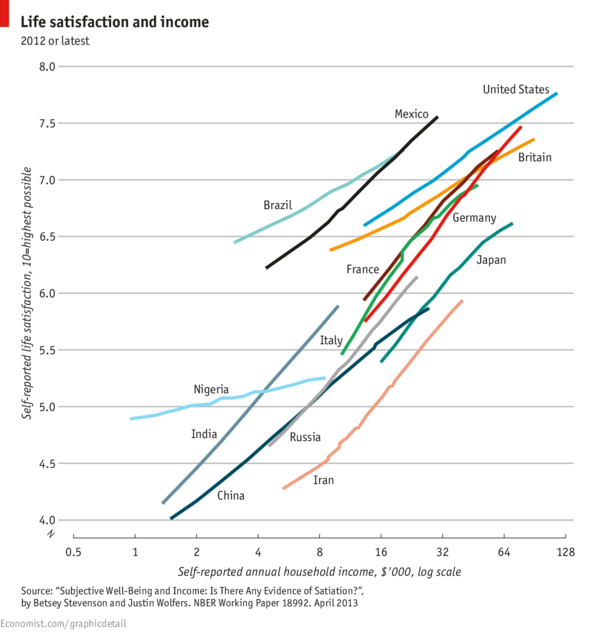An interesting chart from The Economist:
THE Easterlin paradox, named for economist Richard Easterlin, reckons that higher incomes do not necessarily make people happier. Since Mr Easterlin first made his conjecture in 1974, economists’ views have evolved: money matters, studies suggest, but only up to a point. Become rich enough, and a bigger paycheque no longer leads to more happiness. Yet a new NBER working paper by economists Betsey Stevenson and Justin Wolfers, both of the University of Michigan, casts doubt on this chestnut. They use a trove of data generated by Gallup, a polling firm, from its World Poll. Gallup asked respondents around the world to imagine a “satisfaction ladder” in which the top step represents a respondent’s best possible life. Those being polled are then asked where on the ladder they stand (from zero to a maximum of 10), and how much they earn. Though some countries seem happier than others, people everywhere report more satisfaction as they grow richer. Even more striking, the relationship between income and happiness hardly changes as incomes rise. Moving from rich to richer seems to raise happiness just as much as moving from poor to less poor. One never really grows tired of earning more.


I think it’s pretty interesting that they chose a log scale for the income axis. Basically, a steady line as we see here means that some amount of happiness X requires $1,000 for the first X, then $2,000, then $4,000, etc. If you make the curve a normal arithmetic progression along that axis, you see a curve that rapidly flattens out. For example, if you look at these example curves on wikipedia, they are using a graph like the one in the upper right quadrant. If you plotted the numbers straight, as in the upper-left quadrant, you’d see that straight blue line suddenly bend very flat, as predicted by Easterlin.
I think it’s pretty interesting that they chose a log scale for the income axis.
Damn!
I didn’t see that at all. You’re right.
The Brooking’s Institute has weighed in:
http://www.brookings.edu/research/papers/2013/04/subjective-well-being-income
I’m still pissed I missed the scale on the X.
Pingback: Lying with scales | Poison Your Mind